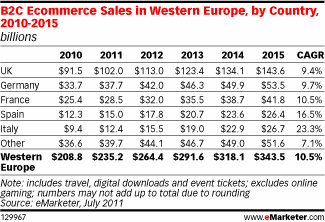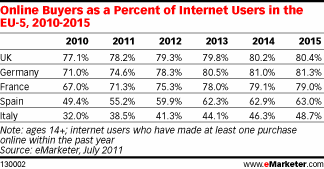eMarketer estimates that in 2013, combined online sales in these countries will reach $121.5 billion and overtake the UK total for the first time. By 2015, spending across the region will reach $343.5 billion, with 58.2% of the total, or $199.9 billion, coming from France, Germany, Italy and Spain.
“Europe’s ecommerce market is a resounding success by any standard,” said Karin von Abrams, eMarketer senior analyst and author of the new report, “Western Europe B2C Ecommerce.” “The number of online buyers in Europe’s four main continental markets is rising steadily as consumer confidence increases and online sellers provide an ever-wider range of goods and services.”

Still, the number of online buyers in these countries as a percentage of internet users varies widely. In the UK and Germany, nearly three-quarters or more of the online population has made a purchase online in the past year, higher than the US rate of 72.6% for 2011. France is not far behind.
But in Spain and Italy, rates of online purchasing are much lower and climbing slowly. One reason is that Italy, like Spain, has no strong tradition of catalog-based home shopping, whereas France and Germany do. As a result, most consumers in Italy are not familiar with evaluating goods based on photos, or ordering and paying for items days before they are delivered.

“As ecommerce grows across the region, each country seems to foster a unique blend of ecommerce habits,” said von Abrams. “For example, mobile phone owners polled in France in 2011 appeared far more likely than those in other EU-5 countries to use their handsets while shopping in stores. Yet France’s mobile users were less likely to make any mobile purchases. Similarly, Italy and Spain will probably never embrace online food shopping as Germany and the UK seem set to do.
“Though levels of online buying will rise in all major European countries, significant variations will persist,” she continued.





